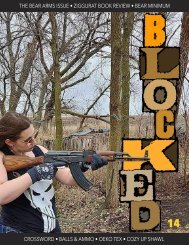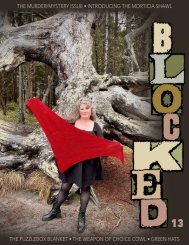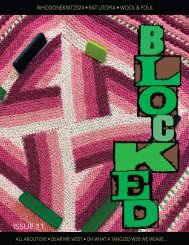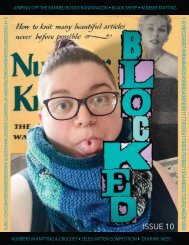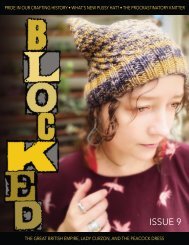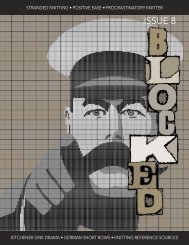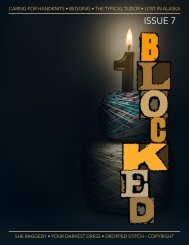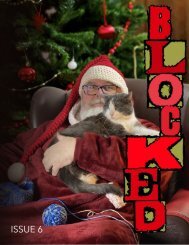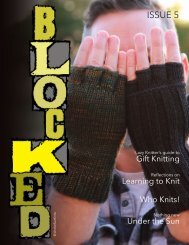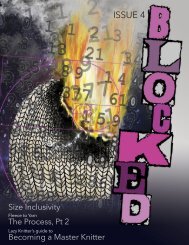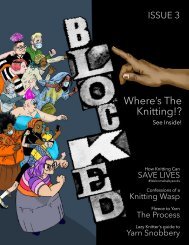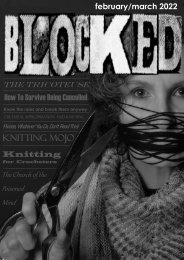You also want an ePaper? Increase the reach of your titles
YUMPU automatically turns print PDFs into web optimized ePapers that Google loves.
Book Reviews... Continued...<br />
At the end of each sweater design, Righetti provides alternative<br />
design options. She includes a detailed chapter<br />
on sleeve design and another on neckline design, both<br />
giving you directions and many different options for how<br />
to incorporate these options into the existing 13 sweater<br />
designs. There is a chapter on additional options, such as<br />
color work, embroidery, striping (with advice on how to<br />
maintain the striping from the body to the sleeves), and<br />
more.<br />
The third section, Appendices, is just that, containing:<br />
• Metric to English Conversion Chart<br />
• Abbreviations<br />
• Finished sizes for pullovers and cardigans for<br />
toddlers, children, men, and women (32 to 40 inch<br />
chest or 81 to 102 cm)<br />
• Personal measurements chart<br />
• Project record form<br />
• Glossary<br />
In my opinion, the first part of the book is well suited<br />
for all knitters who want to knit sweaters. Even if you do<br />
not design your sweater, you will learn so much about<br />
yarn selection, stitch pattern selection, color selection,<br />
and how sweater designing needs to consider the shape<br />
of the human body. For example, you learn why the back<br />
neck needs to be higher than the front neck, why raglan<br />
decreases can lead to extra fabric at the top of the chest<br />
if not planned carefully, and other topics well worth the<br />
read. The second section of the book, where you design<br />
sweaters, gives great direction; however, I am not sure<br />
the novice sweater knitter will be comfortable knitting<br />
their first sweater from this method. I recommend being<br />
comfortable with the basic concepts of knitting sweaters<br />
before you use the second section of this book to design<br />
a sweater.<br />
This is a paperback book with black and white photos<br />
and illustrations. The illustrations are quite helpful and<br />
add to the understanding of the concepts. If you can find<br />
a copy of this book, I recommend it to anyone who wants<br />
to learn about sweater design and finally make that<br />
sweater that fits well and looks great on you or the knitworthy<br />
recipient.<br />
The 13-sweater design concept provided in Sweater<br />
Design in Plain English is similar to Elizabeth Zimmermann’s<br />
sweater designs. Zimmermann does not provide a<br />
pattern, she provides the measurements you need and<br />
from your stitch gauge, you calculate the number the<br />
stitches you need to cast on. She then provides written<br />
instruction in paragraph form for knitting the sweater.<br />
Zimmermann gives you design options, but not anywhere<br />
near the options and the detailed guidance in completing<br />
the calculations and knitting the sweater provided by<br />
Righetti in Sweater Design in Plain English. Zimmermann<br />
does not address body shapes and how to select patterns<br />
to flatter a specific body shape and does not address<br />
color theory in designing. Zimmermann promotes<br />
knitting with wool, while Righetti offers you information<br />
on using other fibers and how the type of fiber affects the<br />
fabric and what other considerations are needed when<br />
selecting fiber for a sweater. Zimmermann offers a lot to<br />
knitters, particularly to those new to knitting, as does Righetti.<br />
I believe there is a place for Zimmermann’s and Righetti’s<br />
work in a knitter’s life and library.<br />
All these many words later I recommend the books reviewed<br />
in the following order:<br />
1. Sweater Design in Plain English<br />
(Righetti & Shaw, 2011)<br />
2. Elizabeth Zimmermann's Knitting Workshop<br />
(Expanded and Updated) (Zimmermann & Swanson,<br />
2014)<br />
3. The Sweater Workshop (Fee, 2002)<br />
Currently, I am knitting a sweater using Anne Budd’s<br />
The Knitter’s Handy Book of Top-Down Sweaters (Budd,<br />
20<strong>12</strong>). I will submit an article reviewing Budd’s book, as<br />
well as Melissa Leapman’s 6000+ Pullover Possibilities, Interchangeable<br />
Options for Custom Knitted Sweaters<br />
(Leapman, 2017) in a later issue.<br />
I wish you Happy Knitting (completely without tears!)<br />
27





